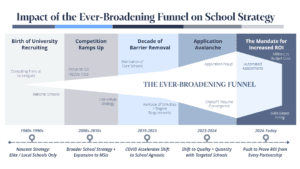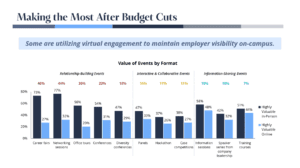June 27, 2025
Campus Recruiting Guide: Proven Strategies to Win Top Talent in 2025
Campus recruiting is entering a new chapter. As Early Career hiring continues to evolve, the business stakes are higher, and student expectations are rising.
At Veris Insights, we’ve conducted extensive research on student preferences and employer branding tactics. The most effective teams are making smarter decisions by prioritizing the right schools and tracking what drives meaningful outcomes.
This guide offers a practical roadmap for building a modern campus recruiting strategy. You’ll find steps for selecting target schools, deepening faculty partnerships, activating your employer brand, and setting Early Career hires up for success.
Understanding the Campus Recruiting Landscape
To understand where campus recruiting is heading, it helps to step back and look at how it has evolved.
In the 1980s and 1990s, campus recruiting was limited in scope. Most companies focused on a small set of elite or local schools, rather than selecting based on strategic alignment.
That began to change in the 2000s, as talent competition intensified and diversity became a higher priority. Employers broadened their reach to include more Diversity-Serving Institutions, such as HBCUs and HSIs.
By the 2010s, virtual engagement was gaining traction. Platforms like Handshake enabled school-agnostic strategies and gave teams new ways to reach students beyond their traditional networks.
The biggest shift came in 2020. When COVID-19 halted in-person engagement, virtual recruiting became the norm. Core school lists were reevaluated, and many teams embraced more open, digital-first approaches to maintain access and equity.
Today, a new transformation is underway. With the rise of Generative AI, students can apply to dozens or even hundreds of jobs in just a few hours. This rapid increase in volume, often called the Application Avalanche, has overwhelmed many recruiting teams and made it harder to evaluate candidate intent or quality.
At the same time, there is growing pressure to show a return on investment. Budgets are leaner, and leaders want clarity on which schools and strategies are delivering value. Recruiters are being asked to focus their efforts and justify every decision with data.
We call this moment The Great Reset. It marks a clear shift from expansion to focus. The goal is no longer to engage the most students, but to engage the right ones. That means aligning school selection with business needs, being selective with resources, and building measurable, scalable strategies.
The chart below illustrates how campus recruiting has evolved over the past four decades, highlighting key milestones and the factors that have shaped today’s environment.

Building Relationships with Campus Resources
In an environment where students are submitting more applications than ever, real engagement stands out. Students want to hear from employers who show up with a purpose and take the time to build genuine relationships on campus.
“If all I’m going to do is scan a link, then I’d rather not see a company and just find information online. But if there are people on the team who can tell me what their day-to-day is like and what the culture feels like, that’s valuable and worth my time.” – Electrical Engineering Major, Class of 2024
To build trust, recruiting teams should focus on the core influencers students interact with every day:
- Career Services: Career centers remain a key entry point. Partnering on résumé workshops, mock interviews, or employer panels helps your team stay visible and involved.
- Faculty and Department Leaders: Professors can be powerful connectors. They know which students are excelling and can make referrals based on real classroom and project experience.
- Student Clubs and Organizations: These groups offer access to highly motivated students with specific interests or career goals. In fact, 69% of employers plan to increase investment in student club partnerships in 2024, building on a strong upward trend.
These relationships only work when they are consistent and authentic. One-off sponsorships or career fair appearances rarely lead to lasting impact. Instead, companies should aim to create a campus presence that extends across seasons and touchpoints.
That could mean hosting informal meetups, offering guest lectures, sharing alumni career stories, or supporting club-led events. When students see your team contributing knowledge, mentorship, and support, they are more likely to view you as a trusted partner, not just a potential employer.
Top Campus Recruiting Challenges in 2025
Challenge 1: Managing Exec Pressure: One of the biggest and most political hurdles University Recruiting (UR) leaders face is pressure from executives and hiring managers to recruit from alma maters or personal preference schools, even when those schools may not align with hiring needs. Successfully navigating these requests requires data-backed storytelling to justify school selection decisions.
Challenge 2: Adapting to Budget Cuts: The majority of UR programs have recently experienced budget cuts, meaning the number of schools they can target is often on the chopping block. UR teams must justify their spend by demonstrating ROI, talent availability, and long-term pipeline impact. Knowing which schools to target for the highest impact, along with knowing the format of that engagement (i.e. virtual to save on travel budgets) is critical.
Challenge 3: Hard to Fill Location Strategy: Many UR teams are shifting toward more regional strategies for two reasons. First, budget cuts, travel restrictions, and having a smaller team are all factors that are pushing leaders to focus recruiting closer to their office hubs. Some companies have responded by training and empowering local employees to support school engagement when recruiters are unable to travel. Second, there is a growing strategic need to focus on regional pipelines, especially when hiring in rural or hard-to-sell locations. Recruiters want to find students who are already familiar with those areas or are more likely to relocate, rather than trying to persuade someone to move across the country to a place they have never visited.
Developing a Targeted Campus Recruiting Strategy
A robust campus recruiting program begins with a strategic framework. Here’s how to craft a plan that resonates with both faculty and students while driving real, measurable results.
Identifying the Right Schools and Programs
Choosing target universities starts with aligning academic strengths and student demographics to your hiring needs.
For instance, if your goal is to find strong tech candidates, you might focus on schools with recognized engineering or computer science programs. Or, if you seek marketing and communications talent, consider institutions with highly regarded liberal arts and journalism curricula.
Collect relevant data:
- Enrollment figures and average class sizes.
- Distribution of majors or research specializations.
- Career center resources and availability of co-op or internship programs.
Use these insights to avoid spreading your efforts too thin. Zeroing in on a handful of high-impact campuses fosters stronger personal connections, enabling you to more effectively identify and engage top talent.
Setting Clear Goals and Objectives
Establish specific objectives and performance metrics to guide your recruiting efforts. Examples could include:
- Filling 10 technical internship roles by May, focusing on software engineering or data analytics.
- Increasing applicants from underrepresented groups in tech by 20%.
- Hosting at least one on-campus networking night or skill-building event per semester.
Tracking these goals throughout the academic year ensures you can measure the success of different initiatives. If you only achieve half your desired number of qualified applicants, it might indicate a need to fine-tune your brand messaging, step up event frequency, or improve follow-up with prospective candidates.
Building a Strong Employer Brand on Campus
Students are interested in more than a paycheck, they want to know how you will support their growth and align with their values. Veris Insights research indicates that Early Career candidates respond most positively to three core themes:
- Career Development: Highlight mentorship programs, rotational opportunities, or robust training pathways.
- Diversity, Equity, and Inclusion: Provide tangible examples of how your company fosters a sense of belonging. Bring current employees who can speak authentically about your inclusive culture.
- Real Impact: Gen Z especially wants to see how their contributions will shape products, customers, and communities.
These personal narratives will illustrate your company values, culture, and commitment to shaping Early Careers.
Engaging with Students
Recruiting on campus goes far beyond showing up at a career fair. Students respond to authentic interactions that give them a clear sense of your culture, day-to-day work, and growth paths.
Practical Ways to Stand Out
- Meaningful events: Organize small group discussions, résumé reviews, or mock interviews with recruiters and hiring managers. Personal conversations often leave a stronger impression than large lecture-style sessions.
- Social media campaigns: Share internship stories, highlights of office life, and application tips on LinkedIn, Instagram, and TikTok. Tag partner universities to extend your reach and invite direct questions from students.
- Personalized follow-up: After collecting student contact details at fairs or webinars, send timely thank-you notes, short recaps, and reminders about deadlines. Thoughtful digital touchpoints paired with in-person workshops and networking nights create a balanced experience that speaks to varied student preferences.
Match the Event to the Format
Candidate feedback shows a clear pattern:
- Events centered on relationship building, such as career fairs or networking receptions, have higher perceived value when held in person.
- Information-sharing sessions, like employer presentations or virtual panels, deliver nearer to the same value online as they do on campus.

This insight lets teams protect travel budgets while still meeting students where they are. Host high-touch, relationship-driven events on campus and move content-heavy sessions online.
Keep School Strategy Fluid
Selecting campuses is not a once-a-decade decision. Student interests, hiring needs, and university programs all shift over time. Treat school selection like product development:
- Track outcomes each season.
- Measure success with clear metrics.
- Iterate based on data and lived experience.
Use the Veris Insights School Strategy Scorecard
Our School Strategy Scorecard brings structure to this process by evaluating each school across quantitative and qualitative dimensions.
Quantitative metrics:
- Hires and intern conversions
- Retention data
- Alignment with diversity goals
Qualitative inputs:
- Strength of career services relationships
- Brand presence on campus
- Recruiter feedback on candidate quality
Balancing data with human insights helps avoid over-reliance on numbers or gut feel alone. When the Scorecard is reviewed regularly, it keeps your school list current and your investments aligned with business priorities.
Tracking the Right KPIs to Strengthen Your Campus Strategy
Campus recruiting season can come and go quickly. Without the right metrics, it can be difficult to understand which efforts are driving results and which need adjustment.
Here are the KPIs that matter most and how they can guide action:
- Event-to-Application Conversion Rates: Track how many students who attend an event go on to apply. This helps you evaluate whether your messaging is compelling and whether the format is effective.
- Offer Acceptance Rates by Channel or School: Use this data to assess how well your brand and candidate experience are resonating across different universities and sourcing methods.
- Diversity Pipeline Metrics: Monitor the number and progression of candidates from underrepresented backgrounds to evaluate whether your outreach is supporting broader inclusion goals.
- Post-Event Feedback: Collect qualitative insights from students, recruiters, and campus partners. Feedback on format and content can surface areas for improvement in future programming.
- Brand Visibility and Social Engagement: Track reach and interaction across LinkedIn, Instagram, and other platforms to understand where your employer brand is gaining traction.
- Hires by Source or Event: This is one of the most direct ways to evaluate return on investment. Knowing which schools, events, or channels lead to actual hires helps you focus time and resources on what works.
Onboarding Best Practices for Campus Hires
Onboarding is your chance to confirm that new hires made the right choice by joining your organization. Some key components:
- Pair each new employee with a mentor. These mentors can be peers or experienced leaders who offer clarity on day-to-day responsibilities and company culture.
- Create a structured onboarding schedule. Cover everything from company policies and team introductions to skill-based workshops that set hires up for success.
- Emphasize Collaboration: Encourage cross-functional meet-and-greets or group projects early on to help new hires build relationships throughout the organization.
Making Campus Recruiting a Competitive Advantage
Building a thriving campus recruiting strategy is an ongoing process of relationship building and careful adjustment.
By targeting the right schools, creating goals that reflect your talent needs, tracking the right KPIs, and prioritizing a welcoming onboarding experience, you can develop a steady pipeline of high-potential candidates who feel connected and invested in your organization.
At Veris Insights, we’ve seen firsthand how a purposeful approach to campus recruiting can dramatically improve offer acceptance rates and boost Early Career retention. Our research, spanning thousands of student perspectives, confirms that authenticity resonates most with the next generation of talent.
To keep learning about best practices in campus recruiting or Early Career engagement, subscribe to the Veris Insights newsletter or explore our data-backed guides.
